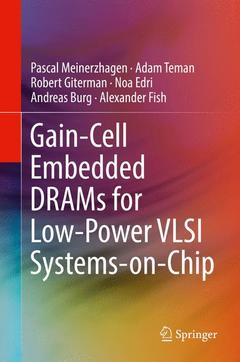Description
Gain-Cell Embedded DRAMs for Low-Power VLSI Systems-on-Chip, Softcover reprint of the original 1st ed. 2018
Language: English
Subjects for Gain-Cell Embedded DRAMs for Low-Power VLSI Systems-on-Chip:
Publication date: 07-2017
Support: Print on demand
Publication date: 05-2018
Support: Print on demand
Description
/li>Contents
/li>Biography
/li>Comment
/li>
This book pioneers the field of gain-cell embedded DRAM (GC-eDRAM) design for low-power VLSI systems-on-chip (SoCs). Novel GC-eDRAMs are specifically designed and optimized for a range of low-power VLSI SoCs, ranging from ultra-low power to power-aware high-performance applications. After a detailed review of prior-art GC-eDRAMs, an analytical retention time distribution model is introduced and validated by silicon measurements, which is key for low-power GC-eDRAM design. The book then investigates supply voltage scaling and near-threshold voltage (NTV) operation of a conventional gain cell (GC), before presenting novel GC circuit and assist techniques for NTV operation, including a 3-transistor full transmission-gate write port, reverse body biasing (RBB), and a replica technique for optimum refresh timing. Next, conventional GC bitcells are evaluated under aggressive technology and voltage scaling (down to the subthreshold domain), before novel bitcells for aggressively scaled CMOS nodes and soft-error tolerance as presented, including a 4-transistor GC with partial internal feedback and a 4-transistor GC with built-in redundancy.
Motivation.- Introduction to Gain-Cell Based eDRAMs (GC-eDRAMs).- GC-eDRAMs Operated at Scaled Supply Voltages.- Near-VT GC-eDRAM Implementations with Extended Retention Times.- Aggressive Technology and Voltage Scaling (to Sub-VT Domain).- Single-Supply 3T Gain-Cell for Low-Voltage Low-Power Applications.- 4T Gain-Cell with Internal-Feedback for Ultra-Low Retention Power at Scaled CMOS Nodes.- Multilevel GC-eDRAM (MLGC-eDRAM).- Soft Error Tolerant Low Power 4T Gain-Cell Array with Multi-Bit Error Detection and Correction.- Conclusions.
Dr. Pascal Meinerzhagen is a Senior Research Scientist at Intel Labs, Intel Corporation, performing research into energy-efficient, error-resilient circuits and systems in high-performance FinFET CMOS technology.
Dr. Adam Teman is a tenure track Senior Lecturer and co-director of the Emerging NanoScaled Integrated Circuits and Systems (EnICS) Labs in the Faculty of Engineering at Bar-Ilan Univeristy. His research interests include energy-efficient digital circuit design with an emphasis on embedded memories and efficient physical implementation of VLSI systems.
Robert Giterman is a researcher Ph.D. student at the Emerging Nanoscaled Intergrated Circuits and Systems (EnICS) Labs in Bar Ilan University, guided by Prof. Alexander Fish and Dr. Adam Teman. He received the B.Sc. degree in electrical engineering from Ben-Gurion University, Be’er Sheva, Israel, in 2013. He completed the M.Sc. degree at Ben-Gurion University in 2014 as part of a fast track program for outstanding students. Mr. Giterman’s research interests include embedded DRAM design and optimization for low power and high performance operation, SRAM design with an emphasis on improved stability, error-correction and fault-tolerant circuits and development of hardware-security oriented embedded memories for use in low-power applications and high-end processors. As part of his research, he led several full test chip integrations and tape out. He has authored/co-authored 15 journal articles and international conference papers and 3 patent applications, and has presented his research at a number of international conferences. In 2014, he was awarded the presidential scholarship for outstanding Doctorate students.
Noa Edri is a design and verification SoC engineer at Nanoscaled Intergrated Circuits and Systems (EnICS) Labs in Bar Ilan University. She received her B.Sc. in Electrical and Computer Engineering from Ben Gurion University, Israel, in 201




